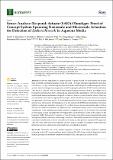| dc.contributor.author | Giacobassi, Cassie A. | |
| dc.contributor.author | Oliveira, Daniela A. | |
| dc.contributor.author | Pola, Cicero C. | |
| dc.contributor.author | Xiang, Dong | |
| dc.contributor.author | Tang, Yifan | |
| dc.contributor.author | Datta, Shoumen Palit Austin | |
| dc.contributor.author | McLamore, Eric S. | |
| dc.contributor.author | Gomes, Carmen L. | |
| dc.date.accessioned | 2021-09-20T14:16:07Z | |
| dc.date.available | 2021-09-20T14:16:07Z | |
| dc.date.issued | 2020-12-23 | |
| dc.identifier.uri | https://hdl.handle.net/1721.1/131307 | |
| dc.description.abstract | Foodborne pathogens are a major concern for public health. We demonstrate for the first time a partially automated sensing system for rapid (~17 min), label-free impedimetric detection of <i>Escherichia coli</i> spp. in food samples (vegetable broth) and hydroponic media (aeroponic lettuce system) based on temperature-responsive poly(N-isopropylacrylamide) (PNIPAAm) nanobrushes. This proof of concept (PoC) for the Sense-Analyze-Respond-Actuate (SARA) paradigm uses a biomimetic nanostructure that is analyzed and actuated with a smartphone. The bio-inspired soft material and sensing mechanism is inspired by binary symbiotic systems found in nature, where low concentrations of bacteria are captured from complex matrices by brush actuation driven by concentration gradients at the tissue surface. To mimic this natural actuation system, carbon-metal nanohybrid sensors were fabricated as the transducer layer, and coated with PNIPAAm nanobrushes. The most effective coating and actuation protocol for <i>E. coli</i> detection at various temperatures above/below the critical solution temperature of PNIPAAm was determined using a series of electrochemical experiments. After analyzing nanobrush actuation in stagnant media, we developed a flow through system using a series of pumps that are triggered by electrochemical events at the surface of the biosensor. SARA PoC may be viewed as a cyber-physical system that actuates nanomaterials using smartphone-based electroanalytical testing of samples. This study demonstrates thermal actuation of polymer nanobrushes to detect (sense) bacteria using a cyber-physical systems (CPS) approach. This PoC may catalyze the development of smart sensors capable of actuation at the nanoscale (stimulus-response polymer) and macroscale (non-microfluidic pumping). | en_US |
| dc.publisher | Multidisciplinary Digital Publishing Institute | en_US |
| dc.relation.isversionof | http://dx.doi.org/10.3390/act10010002 | en_US |
| dc.rights | Creative Commons Attribution | en_US |
| dc.rights.uri | https://creativecommons.org/licenses/by/4.0/ | en_US |
| dc.source | Multidisciplinary Digital Publishing Institute | en_US |
| dc.title | Sense–Analyze–Respond–Actuate (SARA) Paradigm: Proof of Concept System Spanning Nanoscale and Macroscale Actuation for Detection of Escherichia coli in Aqueous Media | en_US |
| dc.type | Article | en_US |
| dc.identifier.citation | Actuators 10 (1): 2 (2021) | en_US |
| dc.contributor.department | Massachusetts Institute of Technology. Auto-ID Laboratory | |
| dc.contributor.department | Massachusetts Institute of Technology. Department of Mechanical Engineering | |
| dc.identifier.mitlicense | PUBLISHER_CC | |
| dc.eprint.version | Final published version | en_US |
| dc.type.uri | http://purl.org/eprint/type/JournalArticle | en_US |
| eprint.status | http://purl.org/eprint/status/PeerReviewed | en_US |
| dc.date.updated | 2021-01-08T14:44:27Z | |
| dspace.date.submission | 2021-01-08T14:44:27Z | |
| mit.license | PUBLISHER_CC | |
| mit.metadata.status | Authority Work and Publication Information Needed | |
